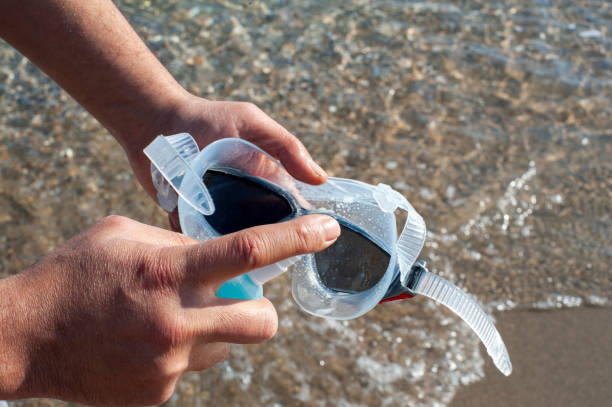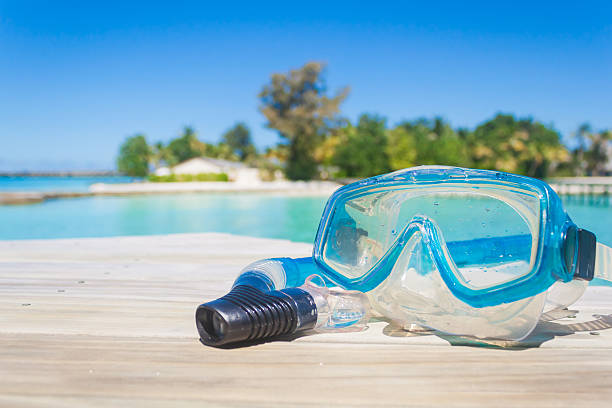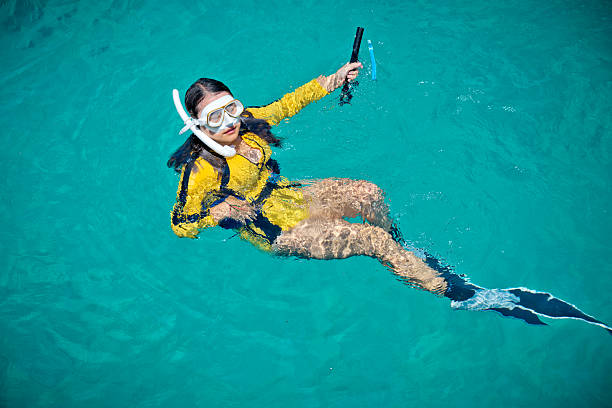पूल में एक लंबे दिन या एक गंभीर प्रशिक्षण सत्र के बाद, आखिरी चीज जो आप चाहते हैं वह है खराब गुणवत्ता वाले चश्मे के कारण असुविधा या धुंधली दृष्टि। यहीं पर हर जोड़ी चश्मे के पीछे की असली कारीगरी सामने आती है। पर्दे के पीछे, तैराकी के चश्मे तैराकी के चश्मे की फैक्ट्री जैसी उच्च तकनीक वाली सुविधाओं में बनाए जाते हैं, जहाँ शीर्ष-स्तरीय उत्पाद देने के लिए सटीकता और नवाचार महत्वपूर्ण हैं। आइए तैराकी के चश्मे कैसे बनाए जाते हैं, इसकी आकर्षक प्रक्रिया में शुरू से अंत तक गोता लगाएँ।
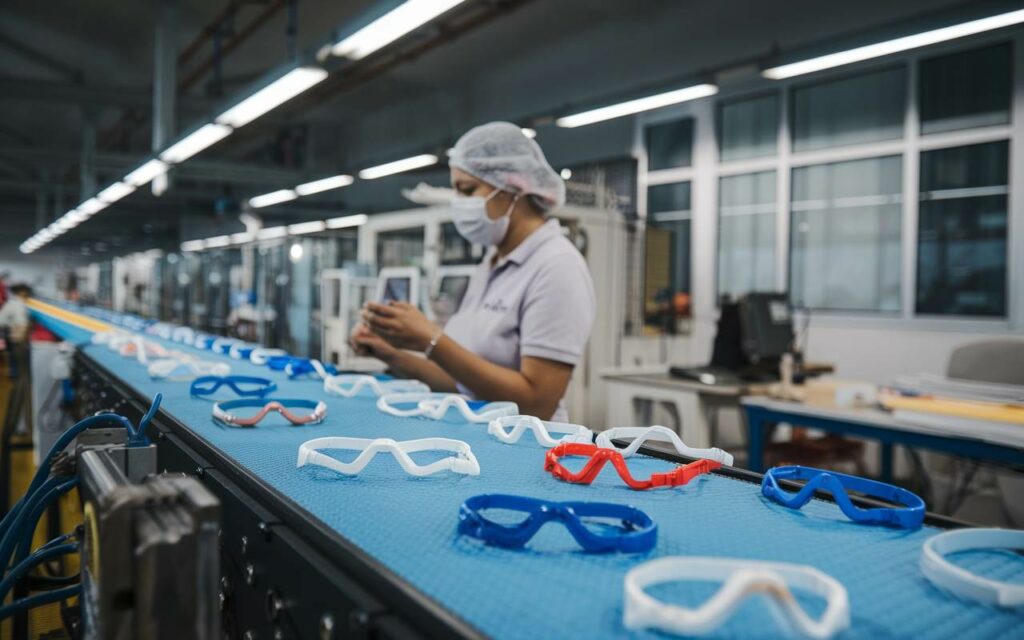
तैराकी के चश्मे किस सामग्री से बने होते हैं?
तैराकी के चश्मे ऐसे पदार्थों के मिश्रण से बनाए जाते हैं जिन्हें उनके लचीलेपन, टिकाऊपन और क्लोरीनयुक्त पानी की कठोर परिस्थितियों के प्रति प्रतिरोध के लिए चुना जाता है। तैराकी के चश्मे के प्राथमिक घटकों में सिलिकॉन, पॉलीकार्बोनेट और थर्मोप्लास्टिक इलास्टोमर्स (TPE) शामिल हैं। लेंस, जो आमतौर पर पॉलीकार्बोनेट से बने होते हैं, हल्के, खरोंच-प्रतिरोधी होते हैं और बेहतरीन ऑप्टिकल स्पष्टता प्रदान करते हैं। सिलिकॉन, जो अपनी कोमलता और लचीलेपन के लिए जाना जाता है, आमतौर पर सील और पट्टियों के लिए उपयोग किया जाता है, जो एक आरामदायक और पानी-रोधी फिट सुनिश्चित करता है। कई तैराकी चश्मे कारखानों में, ये सामग्रियाँ आराम, प्रदर्शन और दीर्घायु का एक संतुलित मिश्रण सुनिश्चित करती हैं, जिससे एक ऐसा उत्पाद बनता है जो सभी स्तरों पर तैराकों की ज़रूरतों को पूरा करता है।
स्विमिंग गॉगल्स फैक्ट्री में विनिर्माण प्रक्रिया
उच्च गुणवत्ता वाले तैराकी चश्मे तैयार करने की यात्रा सटीक योजना और नवीन तकनीकों से शुरू होती है। हरावल, चीनी कारखाने में एक अग्रणी तैराकी चश्मा, प्रत्येक चरण को इष्टतम प्रदर्शन और आराम सुनिश्चित करने के लिए सावधानीपूर्वक डिज़ाइन किया गया है। यहाँ उनका है विनिर्माण प्रक्रिया.
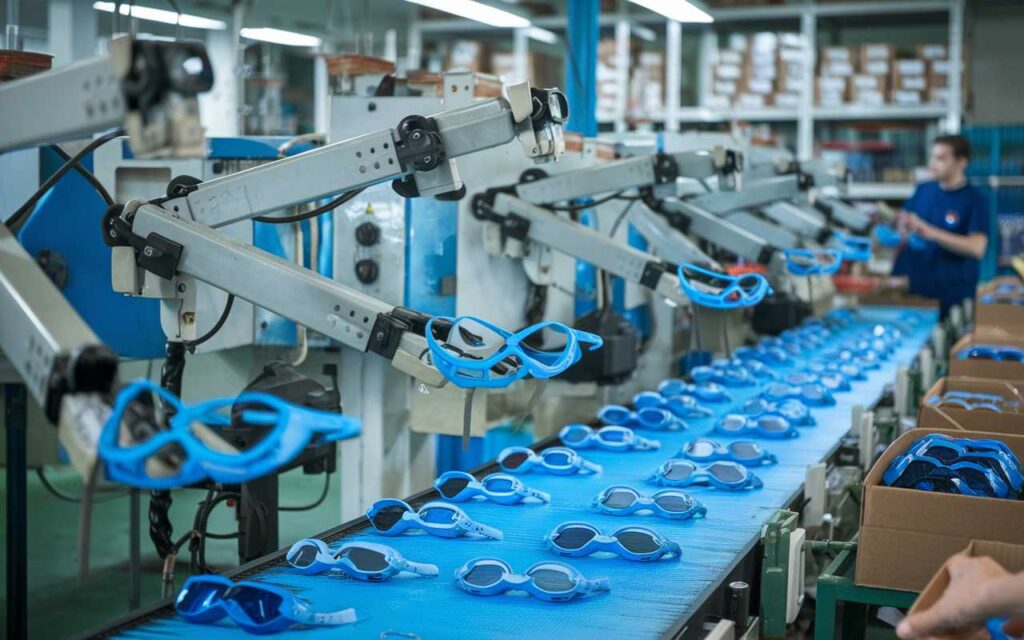
कच्चे माल का निरीक्षण
उत्पादन शुरू होने से पहले, सभी आने वाले कच्चे माल का गहन निरीक्षण किया जाता है। इसमें तैराकी के चश्मे के निर्माण में इस्तेमाल होने वाले सिलिकॉन, पॉलीकार्बोनेट और अन्य सामग्रियों की गुणवत्ता की जाँच शामिल है।
- सिलिकॉन के लिए, विनिर्देश यह सुनिश्चित करते हैं कि यह नरम, लचीला और हाइपोएलर्जेनिक है, जिससे त्वचा को जलन पैदा किए बिना आरामदायक, सुरक्षित फिट हो सके।
- पॉलीकार्बोनेट लेंसों की ऑप्टिकल स्पष्टता, खरोंच प्रतिरोध, तथा जल दबाव और कठोर संचालन को झेलने के लिए प्रभाव स्थायित्व के लिए सावधानीपूर्वक जांच की जाती है।
- फ्रेम के लिए थर्मोप्लास्टिक इलास्टोमर्स (टीपीई) जैसी अन्य सामग्रियों को विशिष्ट स्थायित्व और लचीलेपन के मानकों को पूरा करना होगा।
जब ये सामग्रियां सख्त विनिर्देशों को पूरा करती हैं, तभी वे उत्पादन के अगले चरण में आगे बढ़ते हैं और यह सुनिश्चित करते हैं कि अंतिम उत्पाद टिकाऊ और आरामदायक दोनों हो।
डिजाइन और प्रोटोटाइप
एक बार कच्चे माल को मंजूरी मिल जाने के बाद, अगला कदम डिजाइन और प्रोटोटाइपिंग के माध्यम से तैराकी चश्मे के विजन को जीवंत करना है। यह वह चरण है जहाँ रचनात्मकता इंजीनियरिंग से मिलती है, यह सुनिश्चित करते हुए कि बड़े पैमाने पर उत्पादन शुरू होने से पहले चश्मे के हर पहलू, फिट से लेकर कार्यक्षमता तक, को परिष्कृत किया जाता है। आइए इस महत्वपूर्ण चरण में प्रमुख चरणों को तोड़ते हैं:
- संकल्पना निर्माणडिज़ाइनर बाज़ार की ज़रूरतों और प्रदर्शन लक्ष्यों के आधार पर एक प्रारंभिक अवधारणा विकसित करके शुरुआत करते हैं। इसमें यह निर्धारित करना शामिल है कि चश्मा किस तरह के तैराक के लिए है - पेशेवर एथलीट, आकस्मिक तैराक या मनोरंजन उपयोगकर्ता - और ऐसे डिज़ाइन तत्वों को शामिल करना जो आराम, वायुगतिकी और स्पष्टता को बढ़ाते हैं।
- 3 डी मॉडलिंग: एक बार अवधारणा को अंतिम रूप दे दिया जाता है, तो डिजाइनर चश्मे का आभासी प्रतिनिधित्व बनाने के लिए उन्नत 3D मॉडलिंग सॉफ़्टवेयर का उपयोग करते हैं। इससे उन्हें यह अनुकरण करने की अनुमति मिलती है कि डिज़ाइन कैसा दिखेगा और कैसे काम करेगा, और लेंस वक्रता, फ्रेम फिट और स्ट्रैप प्लेसमेंट जैसे कारकों में समायोजन कर सकते हैं, यह सुनिश्चित करते हुए कि डिज़ाइन सौंदर्य और कार्यात्मक दोनों मानकों को पूरा करता है।
- प्रोटोटाइप परीक्षण: 3D मॉडल पूरा होने के बाद, 3D प्रिंटिंग जैसी रैपिड प्रोटोटाइपिंग तकनीकों का उपयोग करके एक भौतिक प्रोटोटाइप तैयार किया जाता है। प्रोटोटाइप को उसके फिट, आराम और समग्र प्रदर्शन का मूल्यांकन करने के लिए व्यापक परीक्षण से गुजरना पड़ता है। यह एक महत्वपूर्ण चरण है जहाँ वास्तविक दुनिया की प्रतिक्रिया बड़े पैमाने पर उत्पादन के लिए आगे बढ़ने से पहले सुधार के क्षेत्रों की पहचान करने में मदद करती है।
लेंस और फ्रेम को ढालें
डिज़ाइन को अंतिम रूप देने और प्रोटोटाइप का परीक्षण करने के बाद, प्रक्रिया का अगला चरण लेंस और फ़्रेम को ढालना है। इस चरण में सटीक विनिर्माण तकनीक शामिल है ताकि यह सुनिश्चित किया जा सके कि लेंस और फ़्रेम दोनों ही स्थायित्व, फिट और कार्यक्षमता के लिए आवश्यक विनिर्देशों को पूरा करते हैं। यहाँ बताया गया है कि यह कैसे होता है:
- लेंस मोल्डिंग: पॉलीकार्बोनेट, जो अपनी मजबूती और स्पष्टता के लिए जाना जाता है, का उपयोग लेंस बनाने के लिए किया जाता है। सामग्री को गर्म किया जाता है और विशेष रूप से डिज़ाइन किए गए सांचों में इंजेक्ट किया जाता है, जहाँ यह इष्टतम पानी के नीचे की दृष्टि के लिए आवश्यक सटीक वक्रता लेता है। मोल्डिंग प्रक्रिया यह सुनिश्चित करती है कि प्रत्येक लेंस आकार में एक समान हो और खामियों से मुक्त हो, जिससे तैराकों को स्पष्ट, अविकृत दृष्टि मिलती है।
- फ़्रेम मोल्डिंग: फ्रेम, जो आमतौर पर लचीले थर्मोप्लास्टिक पदार्थों से बना होता है, लेंस के साथ मिलकर ढाला जाता है। इस चरण में सामग्री को सांचों में इंजेक्ट करना शामिल है ताकि गॉगल की संरचना के लिए आवश्यक सटीक आकार और आकार बनाया जा सके। यह सुनिश्चित करने के लिए सटीकता आवश्यक है कि फ्रेम तैराक के चेहरे के चारों ओर एक आरामदायक फिट बनाए रखते हुए लेंस को सुरक्षित रूप से पकड़ता है।
- उपचार और शीतलनमोल्डिंग के बाद, लेंस और फ्रेम दोनों ही एक क्योरिंग प्रक्रिया से गुजरते हैं। इस चरण में सामग्रियों को एक निश्चित तापमान पर गर्म करना शामिल है ताकि उन्हें कठोर बनाया जा सके और उनकी स्थायित्व को बढ़ाया जा सके। एक बार ठीक हो जाने के बाद, घटकों को सावधानीपूर्वक ठंडा किया जाता है, जिससे सामग्री जम जाती है और अपना आकार बनाए रखती है, जिससे अंतिम उत्पाद की मजबूती और पानी के दबाव और रोज़मर्रा के पहनने के प्रति लचीलापन सुनिश्चित होता है।
गॉगल के पुर्जे जोड़ें
एक बार लेंस और फ्रेम को ढाला और ठीक किया जाता है, तो प्रक्रिया का अगला चरण असेंबली है। यह चरण तैराकी चश्मे की पूरी तरह कार्यात्मक जोड़ी बनाने के लिए सभी व्यक्तिगत घटकों को एक साथ लाता है। यह सुनिश्चित करने के लिए सटीकता महत्वपूर्ण है कि प्रत्येक भाग निर्बाध रूप से फिट हो और अपने सर्वश्रेष्ठ प्रदर्शन करे। असेंबली प्रक्रिया का विवरण यहां दिया गया है:
- लेंस अटैचमेंटअसेंबली का पहला चरण मोल्डेड लेंस को फ्रेम से जोड़ना है। यह एक नाजुक प्रक्रिया है, क्योंकि लेंस को फ्रेम में बिना हिले या लीक हुए सुरक्षित रूप से फिट होना चाहिए। उच्च गुणवत्ता वाले चिपकने वाले या लॉकिंग तंत्र का उपयोग एक तंग, जलरोधी सील सुनिश्चित करने के लिए किया जाता है, जो उपयोग के दौरान किसी भी असुविधा या दृष्टि हानि को रोकता है।
- सील स्थापना: इसके बाद, लेंस के चारों ओर नरम, लचीली सिलिकॉन सील सावधानी से लगाई जाती हैं। ये सील तैराक के चेहरे के खिलाफ एक जलरोधी अवरोध बनाती हैं, जिससे पानी चश्मे में घुसने से रोकता है। सील फ्रेम को कुशन करके, चेहरे पर दबाव कम करके और एक आरामदायक, सुरक्षित फिट बनाकर आराम भी प्रदान करती हैं।
- पट्टा और नाक पुल विधानसभा: अंतिम असेंबली चरण में समायोज्य पट्टा और नाक पुल जोड़ना शामिल है। टिकाऊ सिलिकॉन या रबर से बना पट्टा, तैराक के सिर के चारों ओर एक सुरक्षित फिट सुनिश्चित करने के लिए फ्रेम से जुड़ा हुआ है। नाक पुल, जो अक्सर समायोज्य होता है, यह सुनिश्चित करता है कि चश्मा बिना किसी परेशानी या परेशानी के विभिन्न चेहरे के आकार पर आराम से बैठे। इन भागों को इकट्ठा करने के बाद, चश्मा परीक्षण और अंतिम समायोजन के लिए लगभग तैयार है।
गुणवत्ता नियंत्रण के लिए परीक्षण
तैराकी के चश्मे पैकेजिंग और शिपमेंट के लिए तैयार होने से पहले, उन्हें एक कठोर गुणवत्ता नियंत्रण प्रक्रिया से गुजरना पड़ता है ताकि यह सुनिश्चित किया जा सके कि वे प्रदर्शन और स्थायित्व के उच्चतम मानकों को पूरा करते हैं। प्रत्येक परीक्षण वास्तविक दुनिया की स्थितियों का अनुकरण करने और किसी भी संभावित दोष की पहचान करने के लिए डिज़ाइन किया गया है। यहाँ प्रमुख गुणवत्ता नियंत्रण परीक्षणों का अवलोकन दिया गया है:
- रिसाव परीक्षणसबसे महत्वपूर्ण परीक्षणों में से एक, रिसाव परीक्षण यह सुनिश्चित करता है कि उपयोग के दौरान चश्मे में कोई पानी न घुस जाए। सील और लेंस अटैचमेंट की अखंडता की जांच करने के लिए प्रत्येक जोड़ी को पानी में डुबोकर परीक्षण किया जाता है। यदि कोई रिसाव पाया जाता है, तो चश्मे को सही फिट और पानी-रोधी सील सुनिश्चित करने के लिए समायोजन के लिए वापस भेज दिया जाता है।
- प्रभाव प्रतिरोध परीक्षणतैराकी के चश्मे को आकस्मिक गिरावट और कठोर हैंडलिंग का सामना करने की आवश्यकता होती है। लेंस और फ्रेम की स्थायित्व का आकलन करने के लिए, चश्मे को एक प्रभाव प्रतिरोध परीक्षण से गुजरना पड़ता है। इसमें उन्हें एक निर्दिष्ट ऊंचाई से एक कठोर सतह पर गिराना शामिल है ताकि यह सुनिश्चित किया जा सके कि वे दरार, बिखर या अपना आकार न खोएं। यह सुनिश्चित करता है कि चश्मे दैनिक उपयोग के लिए पर्याप्त टिकाऊ हैं।
- एंटी-फॉग कोटिंग अनुप्रयोगदृश्यता और आराम को बेहतर बनाने के लिए, लेंस की आंतरिक सतह पर एंटी-फॉग कोटिंग लगाई जाती है। यह कोटिंग उपयोग के दौरान संघनन को बनने से रोकती है, जिससे यह सुनिश्चित होता है कि तैराक अपनी तैराकी के दौरान स्पष्ट दृष्टि बनाए रख सकें। लगाने के बाद, कोटिंग के टिके रहने और अपेक्षित प्रदर्शन को सुनिश्चित करने के लिए चश्मे की प्रभावशीलता का परीक्षण किया जाता है।
- फिट परीक्षणअंतिम गुणवत्ता जांच में विभिन्न प्रकार के चेहरे के आकार और साइज़ पर चश्मे के फिट का परीक्षण करना शामिल है। यह चरण सुनिश्चित करता है कि चश्मा एक आरामदायक, आरामदायक फिट प्रदान करता है, और सील बिना किसी असुविधा के त्वचा पर ठीक से टिकी रहती है। फिट परीक्षण में विभिन्न सिर के आकार को समायोजित करने के लिए पट्टा और नाक के पुल की समायोजन क्षमता की जांच करना भी शामिल है। एक बार जब वे इन सभी परीक्षणों को पास कर लेते हैं, तो चश्मा पैकेजिंग और शिपिंग के लिए तैयार हो जाता है।
पैकेज और लेबलिंग
सभी गुणवत्ता नियंत्रण परीक्षणों को पास करने के बाद, तैयार तैराकी चश्मे को सावधानीपूर्वक पैक और लेबल किया जाता है। परिवहन के दौरान नुकसान से बचने के लिए प्रत्येक जोड़ी को सावधानीपूर्वक सुरक्षात्मक पैकेजिंग में रखा जाता है। लेबलिंग में ब्रांडिंग और अन्य प्रासंगिक विवरणों के साथ-साथ उत्पाद विनिर्देश और उपयोग के निर्देश जैसी महत्वपूर्ण जानकारी शामिल होती है। तैराकी चश्मे के थोक के लिए, यह पैकेजिंग प्रक्रिया यह सुनिश्चित करने के लिए आवश्यक है कि चश्मे सही स्थिति में अपने गंतव्य तक पहुँचें।
गॉगल निर्माण में प्रौद्योगिकी और नवाचार
हाल के वर्षों में तैराकी के चश्मों की दुनिया में नाटकीय रूप से बदलाव आया है, जिसका श्रेय तकनीकी प्रगति और नवीन विनिर्माण तकनीकों को जाता है। जैसे-जैसे उच्च-गुणवत्ता वाले, प्रदर्शन-उन्मुख चश्मों की मांग बढ़ती जा रही है, निर्माता लगातार डिजाइन और कार्यक्षमता की सीमाओं को आगे बढ़ा रहे हैं। यहाँ कुछ प्रमुख तकनीकों और नवाचारों पर एक नज़र डाली गई है जो चश्मों के निर्माण के भविष्य को आकार दे रहे हैं:
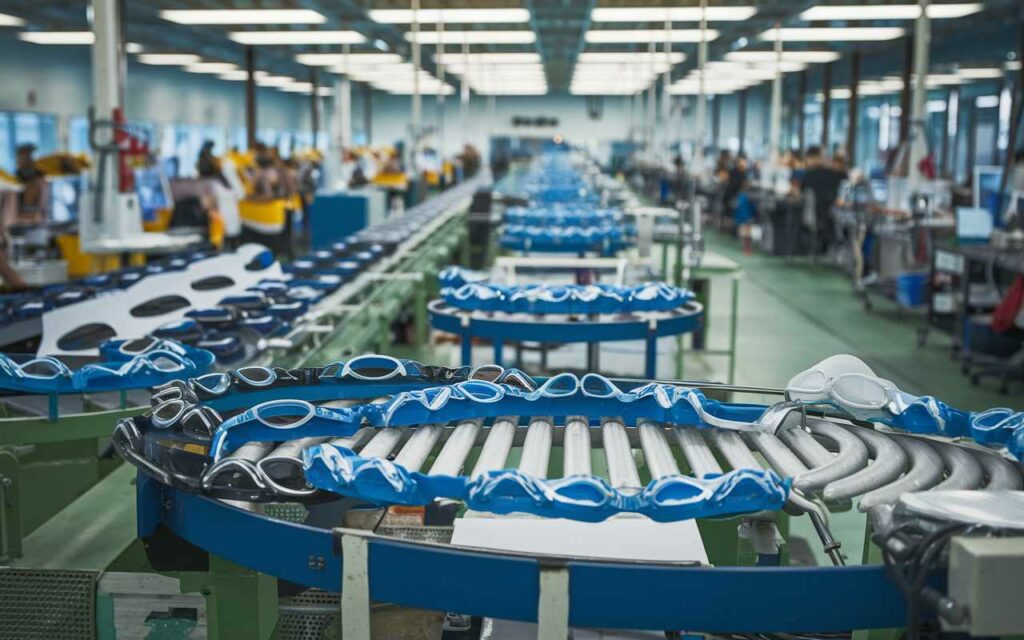
- उन्नत लेंस प्रौद्योगिकी: आधुनिक तैराकी चश्मे अब बेहतर ऑप्टिकल स्पष्टता और कम चमक प्रदान करने के लिए डिज़ाइन किए गए लेंस से सुसज्जित हैं। लेंस कोटिंग्स में नवाचार, जैसे कि एंटी-स्क्रैच, एंटी-फॉग और यूवी-प्रोटेक्शन कोटिंग्स, उच्च-स्तरीय चश्मों में मानक बन गए हैं। इन कोटिंग्स को वैक्यूम डिपोजिशन जैसी उन्नत तकनीकों का उपयोग करके लगाया जाता है, जिससे स्थायित्व और प्रभावशीलता सुनिश्चित होती है।
- हाइड्रोडायनामिक डिजाइनगति में सुधार और ड्रैग को कम करने के लिए, तैराकी के चश्मों का डिज़ाइन वायुगतिकीय रूप से अधिक परिष्कृत हो गया है। निर्माता द्रव गतिकी सिमुलेशन का उपयोग करके ऐसे चश्मे के आकार बना रहे हैं जो पानी में प्रतिरोध को कम करके प्रदर्शन को बढ़ाते हैं। इससे अधिक सुव्यवस्थित चश्मों का विकास हुआ है, खासकर प्रतिस्पर्धी तैराकों के लिए।
- स्मार्ट गॉगल्सहाल के वर्षों में, तैराकी के चश्मों में स्मार्ट तकनीक शामिल की जाने लगी है, जैसे कि बिल्ट-इन डिस्प्ले जो लैप टाइम, स्ट्रोक काउंट और हृदय गति जैसे वास्तविक समय के डेटा दिखाते हैं। छोटे सेंसर और उन्नत डिस्प्ले तकनीक द्वारा संभव बनाए गए ये नवाचार पेशेवर एथलीटों और तकनीक-प्रेमी तैराकों की ज़रूरतों को पूरा करते हैं जो पूल में अपने प्रदर्शन की निगरानी करना चाहते हैं।
- अनुकूलन योग्य फिट: अधिक आराम की मांग ने अनुकूलन योग्य विशेषताओं वाले चश्मों के विकास को बढ़ावा दिया है, जैसे कि समायोज्य नाक पुल और सिलिकॉन जैसी लचीली, नरम सामग्री से बने पट्टियाँ। कुछ कंपनियाँ तैराक के अनूठे चेहरे की आकृति के अनुरूप 3D-मुद्रित चश्मे भी पेश कर रही हैं, जिससे आराम और पानी में जकड़न दोनों में सुधार होता है।
- स्थिरता और पर्यावरण अनुकूल सामग्रीजैसे-जैसे पर्यावरण संबंधी चिंताएँ बढ़ती जा रही हैं, कई निर्माता चश्मे के उत्पादन में संधारणीय प्रथाओं की ओर रुख कर रहे हैं। इसमें फ्रेम और पट्टियों के लिए पुनर्चक्रित या जैव-आधारित सामग्रियों का उपयोग करना, साथ ही पैकेजिंग समाधान शामिल हैं जो अपशिष्ट को कम करते हैं। ये नवाचार विनिर्माण के पर्यावरणीय प्रभाव को कम करने में मदद करते हैं जबकि उपभोक्ताओं द्वारा अपेक्षित उच्च मानकों को बनाए रखते हैं।
निष्कर्ष
तैराकी के चश्मे के कारखाने में सामग्री के सावधानीपूर्वक चयन से लेकर सटीक परीक्षण तक, तैराकी के चश्मे के उत्पादन में हर कदम एक ऐसे उत्पाद को सुनिश्चित करता है जो उच्चतम मानकों को पूरा करता है। चाहे प्रतिस्पर्धात्मक बढ़त हासिल करना हो या बस आराम से तैरना हो, इस प्रक्रिया को समझने से आपके चश्मे के पीछे की गुणवत्ता और तकनीक के प्रति आपकी प्रशंसा बढ़ती है। अपनी अगली तैराकी के लिए सर्वश्रेष्ठ चुनने के लिए तैयार हैं? आज ही हमारे प्रीमियम चश्मे के चयन को देखें।
